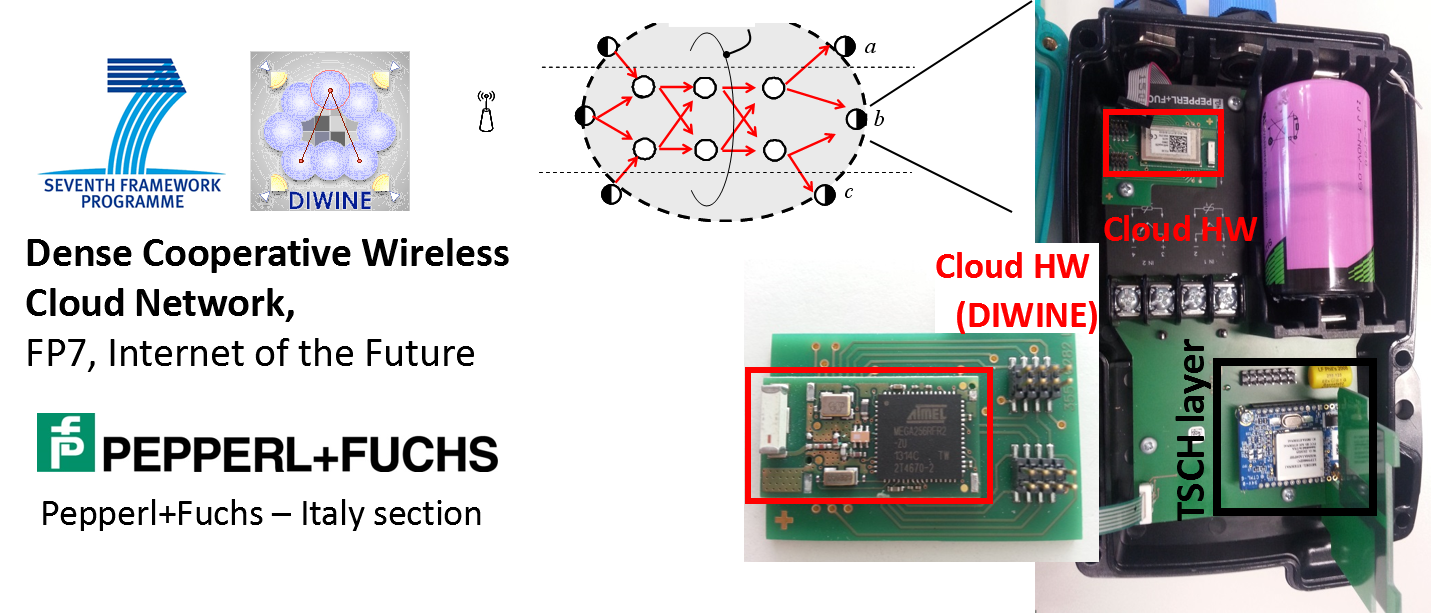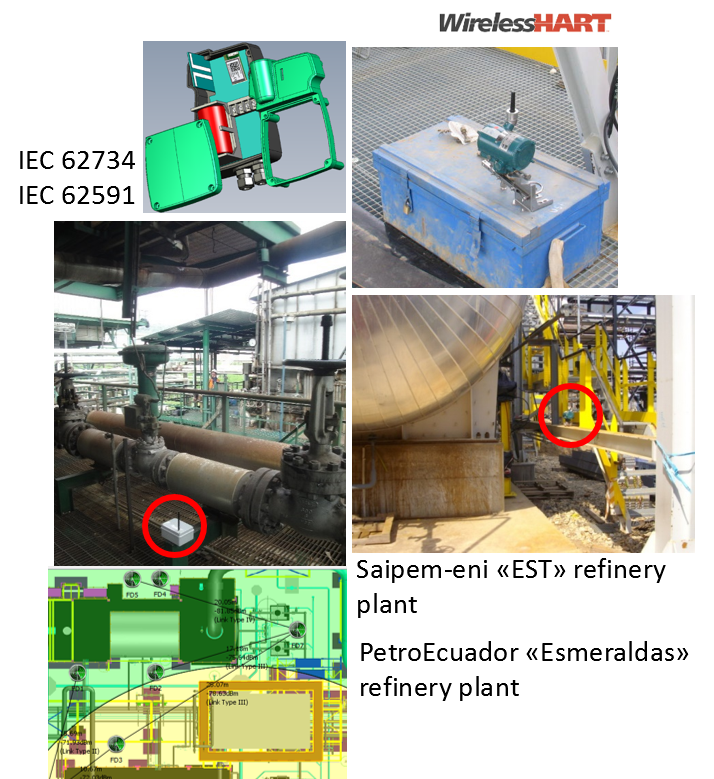Internet of Things for
Industry (iIoT): industrial wireless communications
People (faculty)
Stefano Savazzi, stefano.savazziATieiit.cnr.it
Umberto Spagnolini, spagnoliATelet.polimi.it
Vittorio Rampa, vittorio.rampaATieiit.cnr.it
Monica Nicoli nicoliATelet.polimi.it
Cooperations
AWE
Communications http://www.awe-communications.com/
Politecnico di Milano, DEIB
Pepperl-Fuchs http://www.pepperl-fuchs.com/global/en/3869.htm
Saipem S.p.A. (ENI group)
Yokogawa http://www.field-wireless.com/en/
Projects EU
FP7 Dense Cooperative Wireless Cloud Network (DIWINE) http://www.diwine-project.eu/
Wireless sensor networks (WSNs) are
increasingly gaining impact in our day to day lives. They are finding a wide
range of applications in various domains, including health-care, assisted and
enhanced-living scenarios, industrial and production monitoring, control
networks, and many other fields. Next generation WSN technologies are expected
to be integrated into the “Internet of Things”, allowing for the global interconnection of
heterogeneous smart physical objects with advanced functionalities. Recent
advances of microcontroller design and radio technologies have opened the way
to an emerging category of network-enabled “smart” wireless sensors
(smart-objects) that serve as intelligent agents
for being equipped with low-power dedicated high performance microcontrollers
and a large memory space. Inspired by biological interactions, the
smart-objects establish a distributed “network cloud” to simulate an
“artificial intelligence” characterized by self-configuration, adaptation, and
self-learning capabilities.
The activity investigates the development of
advanced integrated wireless sensor network platforms for communication and
control with special focus on critical industrial applications. Particular focus is on scenarios where the
network cloud of smart devices needs to accomplish specified tasks under very
stringent delay and physical resource constraints. The application scenarios are illustrated in
the following.
Wireless cooperative
networks for industrial applications.
![]() The adoption of WSN in an industrial
context has lately become a strategic issue for most manufacturing companies.
The status of current technology allows the deployment of low power, cost
effective network nodes – often in a battery powered configuration – which
substitute the traditional wired sensors in a very cost effective way. The
opportunity to replace cabling by deploying a network of wireless sensors is
therefore becoming of strategic interest to provide the communication infrastructure
for the next generation “smart factory”.
The adoption of WSN in an industrial
context has lately become a strategic issue for most manufacturing companies.
The status of current technology allows the deployment of low power, cost
effective network nodes – often in a battery powered configuration – which
substitute the traditional wired sensors in a very cost effective way. The
opportunity to replace cabling by deploying a network of wireless sensors is
therefore becoming of strategic interest to provide the communication infrastructure
for the next generation “smart factory”.
Advanced communication and control systems are developed and tested based on IEEE 802.15.4 standard. It is envisaged that the incorporation of the cooperative network paradigm into future system standardization will allow cable-replacing even in tight closed-loop control applications. Cooperative communication enables wireless devices placed at geographically separated locations to act as virtual ensemble of antennas and create a virtual multiple-input-multiple-output (VMIMO) distributed system.
Wireless
closed-loop control
Industrial wireless cloud
platform for critical process monitoring.
 Future
industrial process automation
systems will be underpinned by wireless communication
technology. The use of wireless networks in
industrial applications cannot
be viewed simply as a cable replacement
mechanism: instead, it has the potential
to enhance the functionality
of the entire system by jointly exploiting massively-interacting communication
paradigms and distributed computing. The EU project DIWINE aims at developing
a wireless cloud platform that efficiently exploits
intelligence at field device side to handle critical data publishing and distributed sensing functions. The cloud system acts as
a selfcontained network and it
is designed to interact with devices supporting the Time Synchronized
Channel Hopping protocol
(TSCH) such as the
commercial WirelessHART systems (IEC 62591 standard).
The cloud platform handles the delivery (publishing)
of latency and throughput-critical
data by implementing cooperative networking schemes.
Future
industrial process automation
systems will be underpinned by wireless communication
technology. The use of wireless networks in
industrial applications cannot
be viewed simply as a cable replacement
mechanism: instead, it has the potential
to enhance the functionality
of the entire system by jointly exploiting massively-interacting communication
paradigms and distributed computing. The EU project DIWINE aims at developing
a wireless cloud platform that efficiently exploits
intelligence at field device side to handle critical data publishing and distributed sensing functions. The cloud system acts as
a selfcontained network and it
is designed to interact with devices supporting the Time Synchronized
Channel Hopping protocol
(TSCH) such as the
commercial WirelessHART systems (IEC 62591 standard).
The cloud platform handles the delivery (publishing)
of latency and throughput-critical
data by implementing cooperative networking schemes.
DIWINE demonstrator: industrial
wireless cloud platform for critical process monitoring
Deployment and design of
Internet-of-Things platforms for oil&gas industry
(industrial IoT).
 Large-scale adoption
of dense wireless network technologies in industrial plants is mandatorily
paired with the development
of methods and tools for connectivity prediction and deployment validation. Layout
design procedures must be able
to certify the quality (or
reliability) of network information flow in industrial scenarios
characterized by harsh propagation environments. In addition, these must account for possibly coexisting heterogeneous radio access technologies as part of the
industrial internet of things (iIoT)
paradigm, easily allow postlayout validation steps, and be integrated by industry standard
CAD-based planning systems.
The goal of the activity is
to set the fundamentals for comprehensive
industry-standard methods
and procedures supporting plant designer during wireless coverage prediction, virtual network deployment and
post-layout verification. The proposed
methods carry out the prediction of radio signal coverage considering typical industrial environments characterized by highly dense
building blockage. They also provide a design framework to properly deploy the wireless infrastructure
in interference-limited radio access
scenarios. In addition, the
model can be effectively used
to certify the quality of
machine type communication
by considering also imperfect descriptions of the
network layout. In the pase years the design procedures have been corroborated by experimental measurements in oil refinery sites
(Saipem-eni EST refinery, PetroEcuador Esmeraldas refinery) using industry standard IEEE 802.15.4e, ISA IEC 62734 and
WirelessHART systems (IEC 62591) operating
at 2.4GHz.
Large-scale adoption
of dense wireless network technologies in industrial plants is mandatorily
paired with the development
of methods and tools for connectivity prediction and deployment validation. Layout
design procedures must be able
to certify the quality (or
reliability) of network information flow in industrial scenarios
characterized by harsh propagation environments. In addition, these must account for possibly coexisting heterogeneous radio access technologies as part of the
industrial internet of things (iIoT)
paradigm, easily allow postlayout validation steps, and be integrated by industry standard
CAD-based planning systems.
The goal of the activity is
to set the fundamentals for comprehensive
industry-standard methods
and procedures supporting plant designer during wireless coverage prediction, virtual network deployment and
post-layout verification. The proposed
methods carry out the prediction of radio signal coverage considering typical industrial environments characterized by highly dense
building blockage. They also provide a design framework to properly deploy the wireless infrastructure
in interference-limited radio access
scenarios. In addition, the
model can be effectively used
to certify the quality of
machine type communication
by considering also imperfect descriptions of the
network layout. In the pase years the design procedures have been corroborated by experimental measurements in oil refinery sites
(Saipem-eni EST refinery, PetroEcuador Esmeraldas refinery) using industry standard IEEE 802.15.4e, ISA IEC 62734 and
WirelessHART systems (IEC 62591) operating
at 2.4GHz.
Industrial Internet of Things
(iIoT): deployment and design
Selected
Publications:
S. Savazzi, U.
Spagnolini, L. Goratti, D. Molteni,
M. Latva-aho, M. Nicoli , “Ultra-Wide Band Sensor Networks in Oil and
Gas Explorations,” IEEE Communcations Magazine, vol.51, n.4, pp. 142-153, April
2013
S. Savazzi, V. Rampa, U. Spagnolini “Wireless Cloud
Networks for the Factory of Things: connectivity modeling
and layout design,” IEEE Internet of Things Journal, (pdf) vol.1, no.2, pp.180-195, April 2014.
S. Savazzi,
“Wireless Virtual Multiple Antenna Networks for Critical Process Control:
protocols and experiments” International
Journal of Distributed Sensor Networks, Hindawi
Publishing Co. ISSN: 15501477, 2013.
R. Hugo de Souza, S. Savazzi, L. Buss
Becker “Network Design and Planning
of Wireless Embedded Systems for Industrial Automation,” Design Automation of Embedded Systems, Springer, Open Access
link, 2015,
doi:10.1007/s10617-015-9162-0
S. Savazzi,
S. Guardiano, U. Spagnolini, “Wireless sensor network
modeling and deployment challenges in oil and gas
refinery plants” International Journal of
Distributed Sensor Networks, (pdf), Hindawi Publishing Co. ISSN: 15501477, April 2013
J. M. Winter, I. Muller, G. Soatti,
S. Savazzi, M. Nicoli, L. B. Becker, J. C. Netto and
C. E. Pereira, “Wireless Coexistence and Spectrum Sensing in Industrial Internet of
Things: An Experimental Study,” International
Journal of Distributed Sensor Networks, Hindawi,
2015.
P. Castiglione, S. Savazzi, M. Nicoli, T. Zemen, “Partner selection in indoor-to-outdoor cooperative
networks: an experimental study,” IEEE
Journal on Selected Areas in Communications, Theories and Methods for
Advanced Wireless Relays, vol. 31, no. 8, August 2013.
C. Morelli C., M. Nicoli, V. Rampa, U. Spagnolini, “Hidden Markov Models
for radio localization in mixed LOS/NLOS conditions,” IEEE Trans. on Signal Processing, Vol. 55, No. 4, pp. 1525-1542,
April 2007.
L. Ascorti, S.
Savazzi. E. Sisinni, S. Galimberti, “A wireless cloud network platform
for critical data publishing in industrial process automation,” Proc of
IEEE Sensor Applications Symposium (SAS), Catania, Italy, April 2016.
L. Ascorti, S. Savazzi, S. Galimberti, “Cloud-based WirelessHART networking
for Critical Industrial Monitoring and Control,” (pdf) Proc. of IEEE
International Conference on Industrial Informatics (INDIN 2014), Porto Alegre,
Brazil, July 2014.
J. Winter,
I. Muller, S. Savazzi, L. Becker, J. C. Netto, C. E.
Pereira, “Coexistence
issues in Wireless Networks for Factory Automation,” (pdf) Proc. of IEEE
International Conference on Industrial Informatics (INDIN 2014), Porto Alegre,
Brazil, July 2014.
S. Savazzi, S. Guardiano,
U. Spagnolini, “Wireless Critical Process Control in oil and gas refinery
plants,” Proc. of IEEE International Conference on Industrial Technology (ICIT
2012), Kos Island, Greece, March 2012.
S. Savazzi, M. Nicoli, M. Riva, “Radio Imaging
by Cooperative Wireless Network: localization algorithms and experiments,”
Proc. of IEEE Wireless Communications and Networking Conference (WCNC 2012),
Paris, France, April 2012.
M. Spadacini, S.
Savazzi, M. Nicoli, S. Nicoli, “Wireless Networks for Smart Surveillance:
technologies, protocol designs and experiments,” Proc. of IEEE Wireless
Communications and Networking Conference (WCNC 2012), Workshop on Internet of
Things Enabling Technologies, Paris, France, April 2012.
G. Soatti, M.
Nicoli, S. Savazzi, U. Spagnolini, “Distributed
sensing of interference pattern in Dense Cooperative Wireless Networks,”
Proc. of IEEE Int. Conf. on Communications (ICC), London U.K., June 2015.
M. Nicoli, G. Soatti,
S. Savazzi, “Distributed
estimation of macroscopic channel parameters in dense cooperative wireless
networks” (pdf)
Proc. of IEEE Wireless Communications and Networking Conference (WCNC 2014),
Istanbul, Turkey, April 2014.